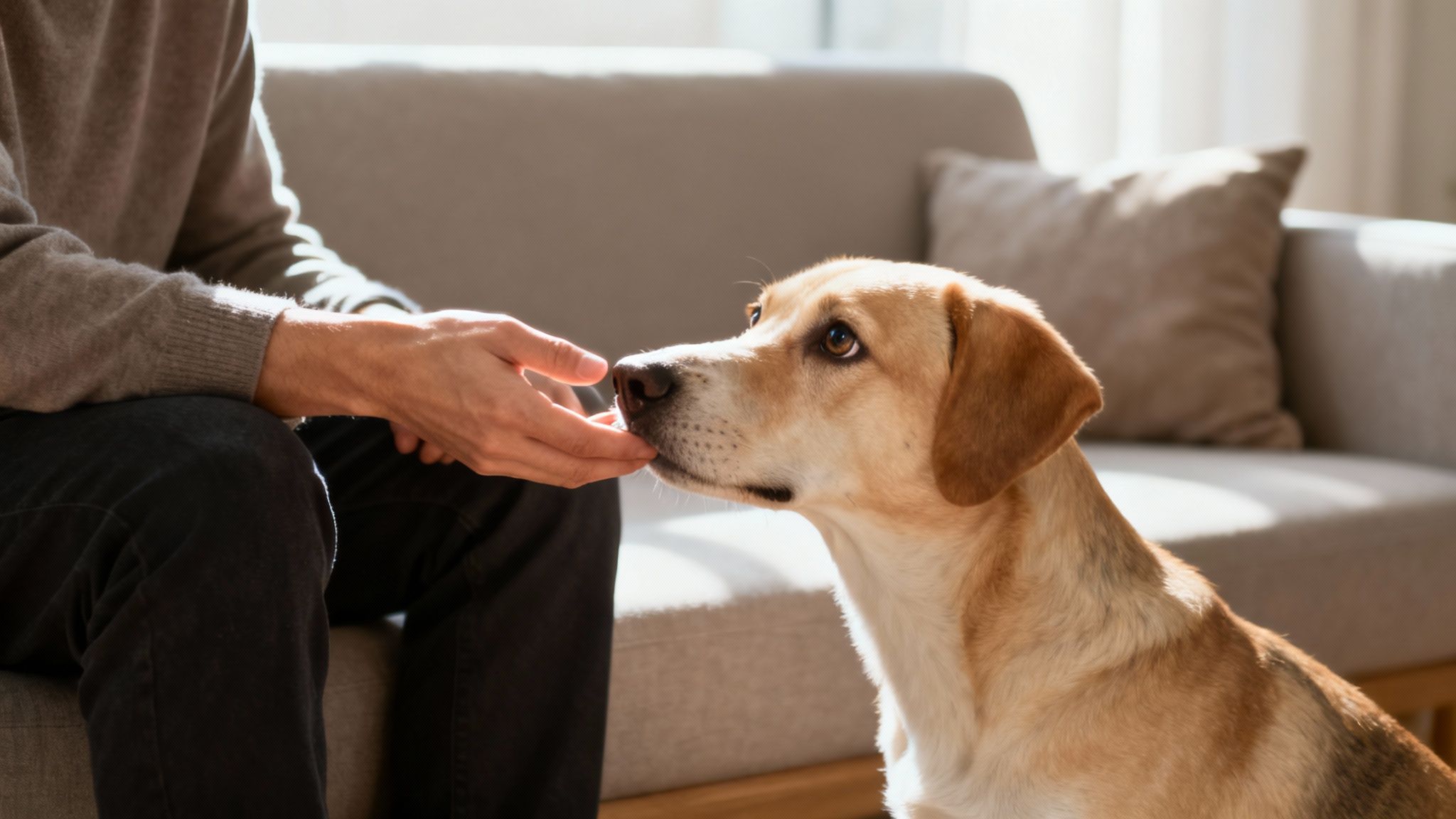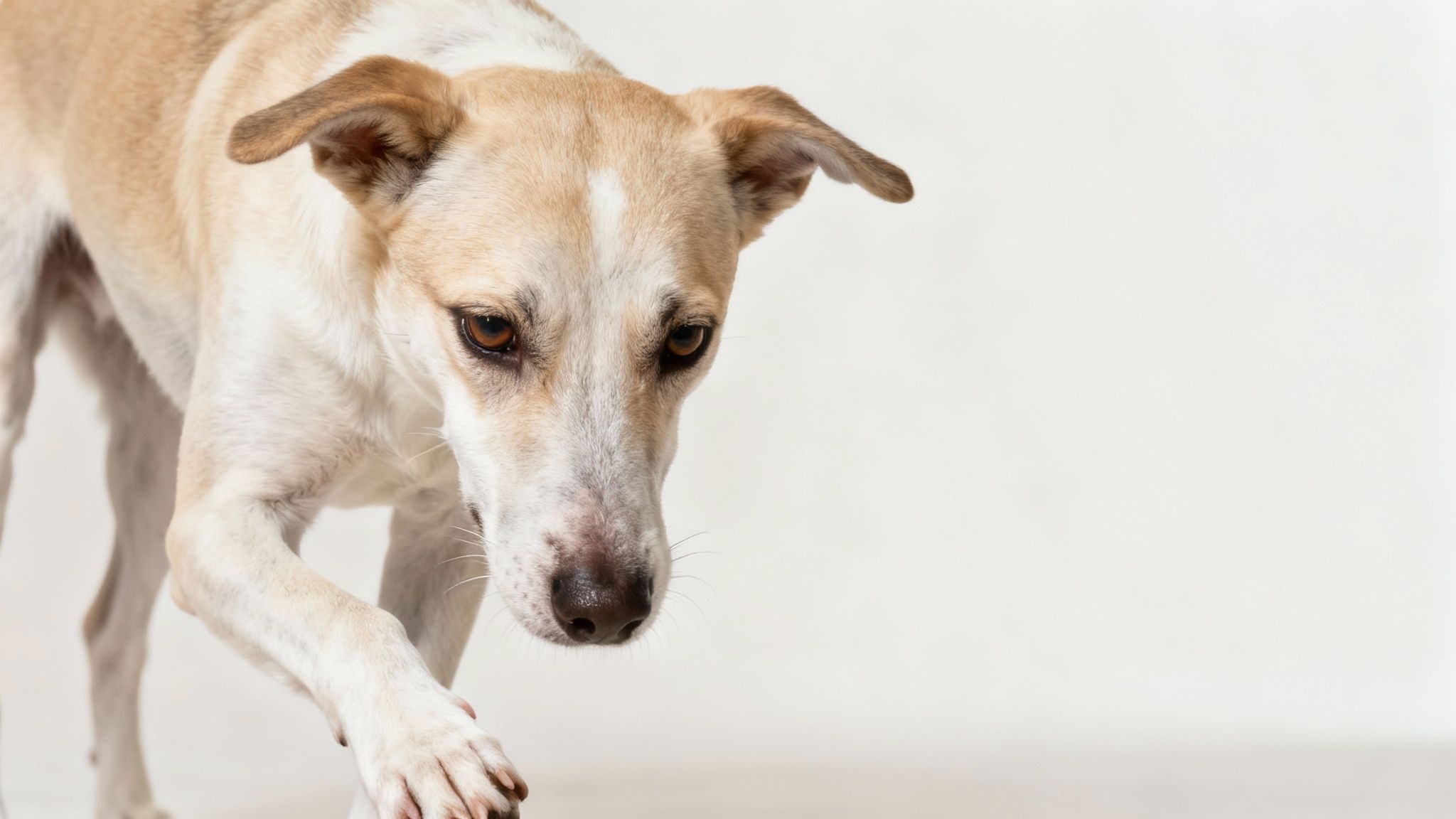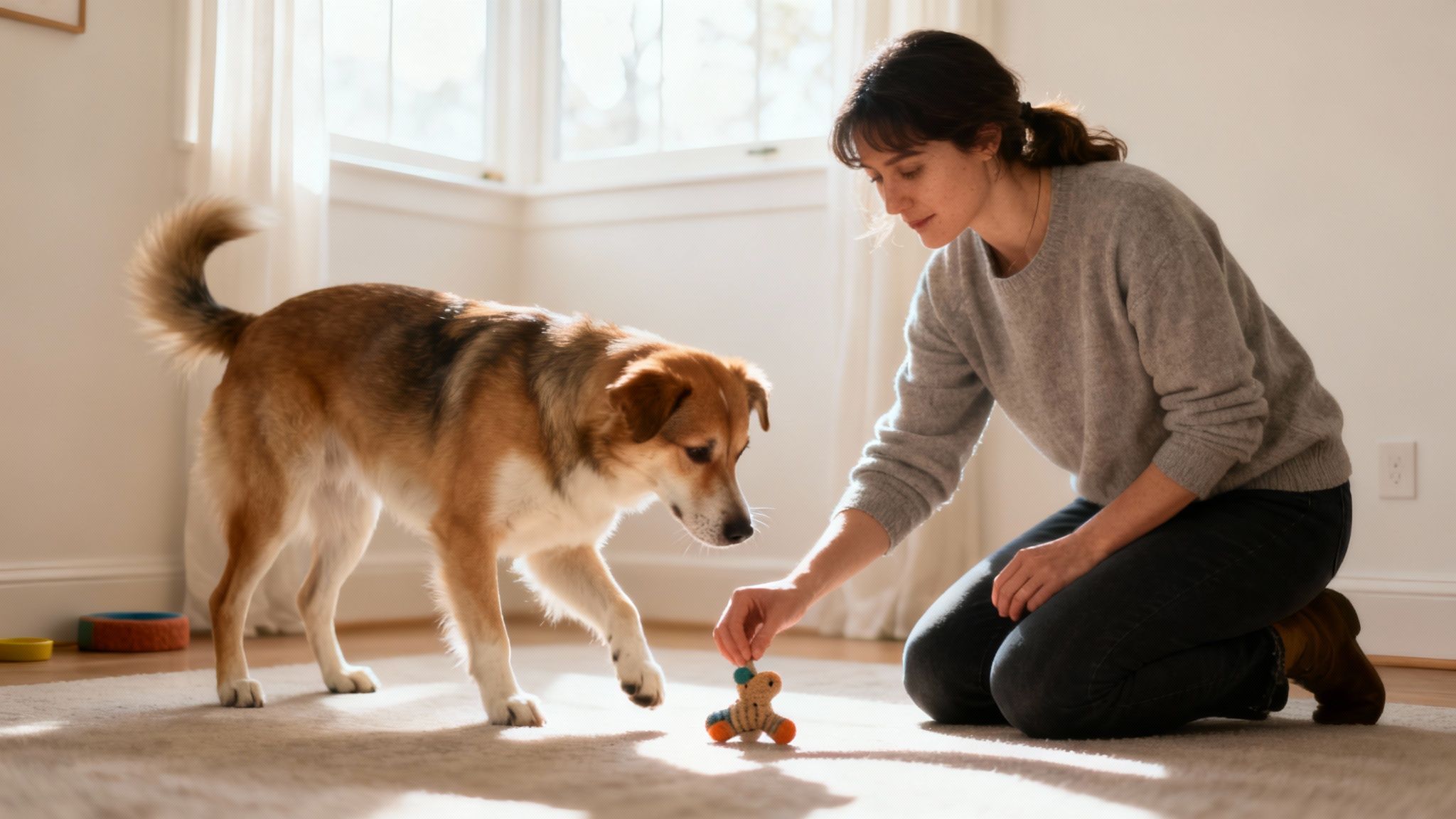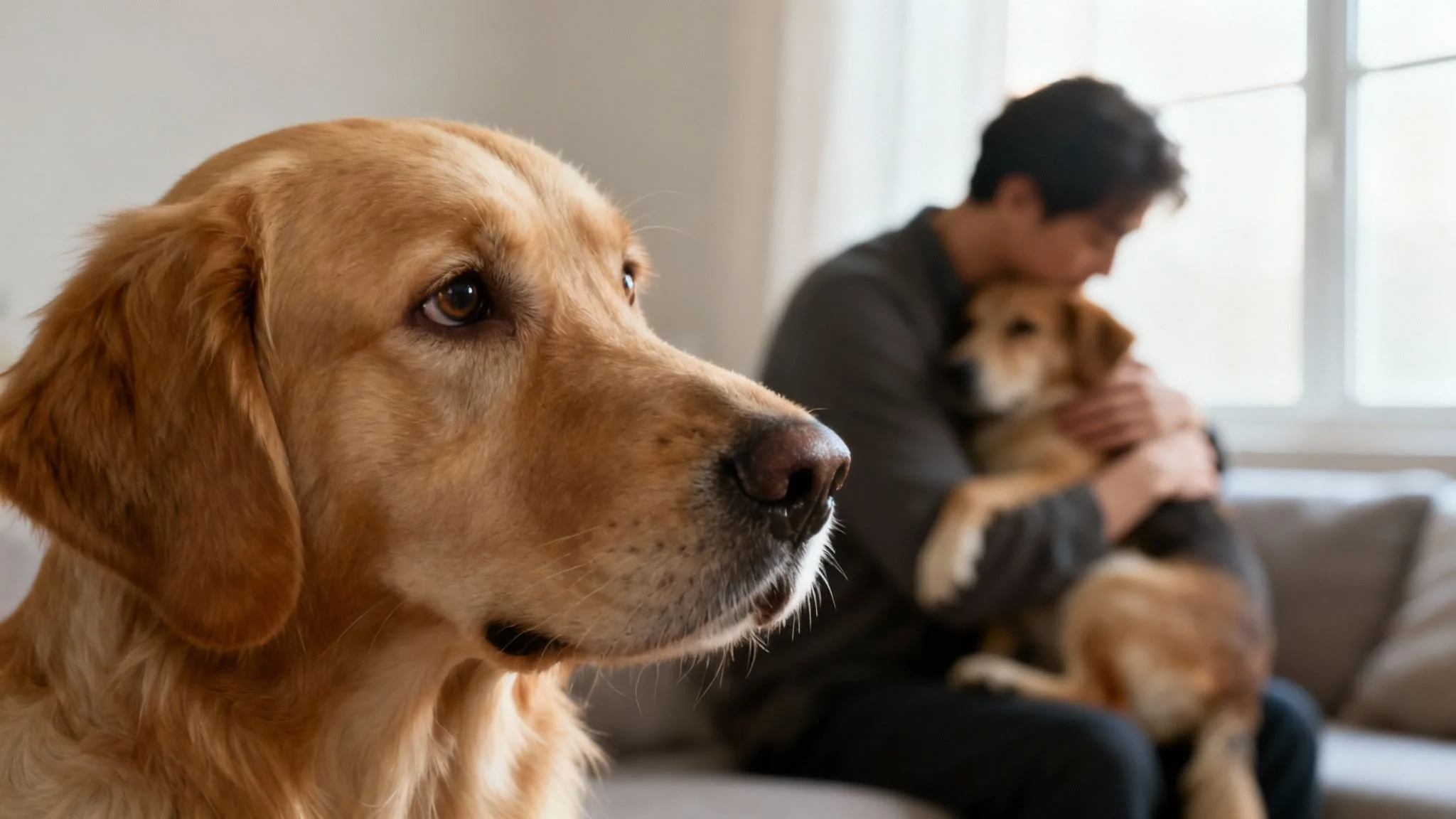Do Dogs Get Jealous? Understanding Canine Envy
Table of Contents
The Green-Eyed Monster in Your Living Room
The Science Behind Canine Jealousy
How to Recognize the Signs of a Jealous Dog
Common Triggers for Jealousy in Dogs
How to Nurture Harmony in Your Pack
When You Should Seek Professional Guidance
Frequently Asked Questions About Dog Jealousy
Key Takeaways
Dogs experience a primary emotion akin to jealousy, rooted in their instinct to protect important social bonds.
Common signs include pushing, whining, getting between you and others, or unusual vocalizations and growling.
Triggers often involve perceived rivals for your attention—think new pets, babies, or even other people.
Managing jealousy means building security through predictable routines, dedicated one-on-one time, and instinct-fulfilling activities like nosework.
If these behaviors escalate into aggression, seeking professional guidance is a crucial step for the well-being and safety of your entire pack.
The Green-Eyed Monster in Your Living Room
Ever wondered if that pushy nudge from your dog is a sign of something more? The short answer is a resounding yes. While we can't know for sure if they feel the exact same green-eyed envy we do, studies and real-life stories confirm that dogs experience a complex, primal emotion very similar to human jealousy, especially when their bond with you feels threatened.
That feeling you get when your dog wedges themselves between you and your partner on the couch isn't just in your head. It’s a real, instinct-driven behavior. For years, many chalked up complex emotions like jealousy in dogs to simple anthropomorphism—basically, us just projecting our own feelings onto our pets. But that old-school view is definitely changing.
Modern research and countless experiences from dog owners tell a much different story. They reveal that this behavior isn't just a quirky habit; it’s a powerful signal coming straight from your dog's inner world. It's all tied to their deep-seated need to protect their most valuable resource: their relationship with you.
This protective drive is really a whisper from their wild ancestry. In a pack, a strong social bond meant access to food, safety, and a secure place in the group. When that bond appears threatened—even by a friendly visitor or a new puppy—their ancient instincts can kick into high gear. They aren't trying to be "bad"; they're trying to secure their connection.
Understanding this helps us see their actions not as a behavioral problem but as a form of communication. It’s an invitation to look deeper, strengthen your bond, and reassure your furry family member of their irreplaceable place in your pack.
The Science Behind Canine Jealousy

Ever get "the look" from your dog and feel a pang of guilt? That feeling is more than just you projecting your own emotions. For years, we debated whether dogs could feel something as complex as jealousy, but science is now catching up to what so many of us have seen with our own eyes.
These behaviors aren't just random acts of neediness. They're wired into a deep, instinctual drive to protect one of their most valuable resources: their bond with you.
At its core, what we call canine jealousy is really about safeguarding a crucial relationship. When your dog sees your attention shift to a perceived rival—another dog, a new partner, or even the baby—it can trigger an ancient insecurity about their standing in the family pack.
A Landmark Study on Canine Envy
For a long time, the idea that dogs get jealous was purely anecdotal. That all changed with a groundbreaking study from the University of California, San Diego, which was the first to experimentally test for these behaviors. Researchers watched how dogs reacted when their owners deliberately ignored them to interact with different objects.
The most telling moments came when owners poured affection onto a realistic stuffed dog—one that could bark, whine, and wag its tail. Faced with this faux rival, the real dogs showed significantly more jealous behaviors. They’d push, snap, and physically try to get between their owner and the toy dog. You can read the full, fascinating findings over on the UCSD website.
This study was huge. It provided compelling evidence that a dog’s reaction isn't just about losing attention in general, but about losing it to what they see as a social competitor. It gives us a powerful window into the rich emotional world our dogs are living in.
An Echo from the Wild
So where does this powerful, green-eyed emotion even come from? The roots of jealousy stretch far back into a dog's ancestral past. For their wild ancestors, holding a strong position within the pack was literally a matter of survival.
A secure social standing guaranteed access to everything that mattered:
Food and water
Protection from predators
Mating opportunities
The safety of the entire group
If a pack member's bond with a leader was threatened, it could jeopardize their very existence. The behaviors we label as "jealousy" today likely evolved as a survival mechanism—a way to actively guard their place in the social hierarchy and avoid being pushed to the fringes.
Today, your home is their pack, and you are the center of their universe. When they nudge their head under your hand or whine as you pet another dog, they're tapping into that same primal instinct. They are communicating a profound need for reassurance that their place in your heart, and in your pack, is safe. Deepening your understanding of canine behavior can completely transform how you interpret—and respond to—these important signals.
How to Recognize the Signs of a Jealous Dog
Figuring out if your dog is feeling jealous starts with learning their unique language. Their actions aren't random—they're signals, little whispers from their inner world asking for reassurance. When we learn to listen, we can turn these confusing moments into chances to build a deeper, more instinctual connection.
The signs can be surprisingly subtle or incredibly direct, but they almost always point back to a feeling of insecurity. It’s not just in our heads, either. A recent study from the University of Auckland found that over 80% of dog owners have seen behaviors they’d call jealous.
This research helped confirm that dogs can mentally picture situations that make them feel insecure—a complex skill once thought to be exclusively human. You can read more about these fascinating findings on canine jealousy and what they mean for our furry friends.
Body Language and Physical Cues
Your dog's body is a roadmap to their emotions. These physical signs are often the very first clue that they feel their bond with you is being threatened.
Pushy Nudging or Pawing: This isn't just a simple request for a scratch. A dog who repeatedly pushes their head into you or paws at you when your attention is elsewhere is actively trying to pull your focus back to them. It’s a classic move to reclaim their spot as the center of your universe.
Getting in the Way: Does your dog suddenly become a furry roadblock, physically planting themselves between you and another person or pet? This is a clear attempt to manage the situation and control access to you—their most prized resource.
Unusual Vocalizations: Whining, whimpering, or uncharacteristic barking when you’re interacting with someone else are all auditory signals of their distress. They're using their voice to let you know they're uncomfortable and need your attention, now.
Behavioral Shifts and Regressions
Sometimes, the signs are less about single actions and more about a shift in your dog’s overall behavior. These changes can be telling indicators that they feel unsettled about their place in the pack.
A common reaction is reverting to puppy-like habits, like having accidents in the house even if they're perfectly house-trained. This isn't spite; it's a sign of stress. It’s a subconscious attempt to get the kind of attention they received when they were young and vulnerable.
Another powerful way to build their confidence is through nosework. Engaging their incredible sense of smell taps directly into their innate instincts. This provides a calming and fulfilling activity that reminds them of their natural capabilities. Want to get started? Download our free guide to dog nosework and begin rewilding your connection today.
Common Triggers for Jealousy in Dogs

That flash of jealousy in your dog rarely comes out of nowhere. It's almost always a reaction to a shift in their world—a disruption to the predictable, comfortable rhythm of their pack. Figuring out what sets them off is the first step toward seeing the situation through their eyes.
These aren't moments of your dog being "bad" or difficult. Far from it. They're communicating a deep, instinctual need for reassurance at the exact moment their place in the family feels a little shaky.
Changes in the Pack Structure
From your dog’s perspective, your family unit is their pack. Any change to that core group, big or small, can feel like a seismic event, sparking some serious insecurity about where they stand.
A New Pet: This is the classic trigger. Bringing home a new puppy or kitten means your time, attention, couch space, and toys now have to be shared. That can feel like a direct threat to the special bond your dog thought you had.
A New Human: Whether it's a new partner moving in or the much-anticipated arrival of a baby, these are monumental shifts for a dog. They might see this new person as a direct rival for your affection, your lap, and your protection.
A Visiting Guest: Even a temporary guest can throw off the pack's energy. Your dog might suddenly become extra protective or pushy, trying to manage this new dynamic and make sure they haven’t been demoted.
Divided Attention and Social Rivals
It doesn't always take a whole new family member to stir up that jealous feeling. Sometimes, just shifting your focus is enough to trigger their insecurity.
A simple hug with your partner on the sofa or getting lost in a long phone call can leave your dog feeling like they're on the outside looking in.
Interactions with other dogs are another huge one. Think about it: you're at the park and you stop to greet another friendly dog. To your dog, your cheerful tone and friendly pats might feel like a betrayal. From their wild-rooted point of view, you’re giving valuable resources (your affection!) to a dog outside of their pack, and that can feel very threatening. If you're looking for guidance, learning how to socialize your dog with other dogs in a positive way can do wonders for their confidence in these exact situations.
The goal isn’t to stop living your life or avoid these everyday moments. It's about recognizing what sparks these feelings so you can approach them with more empathy. It’s a subtle but powerful shift from seeing a "bad dog" to seeing a dog communicating a deeply felt need for security in their world.
How to Nurture Harmony in Your Pack
When you see what looks like jealousy in your dog, it's easy to jump to conclusions. But that behavior isn't a power grab or a demand for control. It's really a call for connection.
Creating harmony in a multi-dog household isn't about imposing rigid commands. It's about building your dog's confidence from the inside out, honoring the deep, instinctual needs that make them who they are.
Think of that jealous behavior as a signal. It’s your dog's way of telling you they feel a little insecure about their place in the pack. When we address that root insecurity, we help them feel more grounded and fulfilled. This approach turns moments of tension into powerful opportunities to strengthen your bond and make jealousy a thing of the past.
Awaken Their Primal Instincts with Scent Work
One of the most powerful ways to build a dog's confidence is to light up their most primal sense—their nose. Scent work, or nosework, is so much more than a fun game. It's a deeply grounding activity that taps directly into their wild nature, giving them a focused, satisfying outlet for all that mental energy.
Giving your dog a "job," like finding a specific scent, empowers them. They feel capable and successful entirely on their own terms, which builds incredible self-assurance—the perfect antidote to insecurity. This isn't just theory; it's backed by science. Neuroimaging research has shown that the emotional centers of a dog's brain light up when they watch their owner interact with a perceived rival. You can explore the fascinating brain-imaging evidence of jealousy in dogs to see just how deep these feelings can run. Scent work provides a productive way to channel that emotional energy into something positive.
Ready to give it a try? You can start exploring this amazing activity today by downloading our free guide to dog nosework:
👉 https://www.withwildpack.com/dognoseworkguide
Create Predictable Rhythms and Rituals
Dogs are creatures of habit who find deep comfort in predictability. A consistent daily rhythm creates a powerful sense of safety and stability, letting them relax because they know what to expect and when. They aren't left anxiously wondering when their needs will be met.
Dedicated One-on-One Time: Carve out just 10-15 minutes each day for uninterrupted time with each dog. Put your phone away and give them your full attention. It could be a gentle grooming session, a quiet cuddle on the couch, or a quick, fun training game.
Structured Pack Walks: A walk is never just a potty break; it’s a crucial pack activity. Moving together reinforces positive social bonds and a shared sense of purpose. It helps every single dog feel like a valued, essential member of the team.
Consistent Routines: Predictable feeding times, walks, and bedtime rituals are incredibly grounding for a dog. This daily structure is inherently calming and reinforces their secure place within the family's life.
These simple practices are the foundation of a dog's emotional well-being. By creating a stable environment and nurturing their individual spirit, you cultivate a truly harmonious pack dynamic. For more ideas on fostering a calm and self-assured companion, you can check out our guide on dog confidence building.
When You Should Seek Professional Guidance
Most of the time, those little nudges and whines your dog offers are harmless signals you can manage with patience and mindful adjustments. But sometimes, these behaviors can hint at deeper currents of anxiety or aggression that need a little extra support to navigate safely.
Recognizing when to ask for help is a loving, responsible act that honors the well-being of your entire pack. It’s not a sign of failure; it’s a commitment to understanding your dog’s needs on a profound level.
Red Flags to Watch For
If you notice jealousy tipping into more intense or unpredictable reactions, it's time to pay closer attention. These behaviors can be a sign that your dog is feeling overwhelmed and unable to cope with their big emotions.
Look for patterns like:
Growling that escalates into snapping, lunging, or biting.
Extreme distress when you interact with another person or pet, like frantic barking or destructive behavior.
Resource guarding that becomes possessive or aggressive around food, toys, or even you.
An inability to settle or relax when a perceived "rival" is present.

Finding the Right Guide
When you're ready to seek support, it helps to know who to call. A certified professional dog trainer is a fantastic resource for managing common behavioral issues through positive reinforcement and skill-building. They can offer practical strategies and effective dog behavior modification techniques.
However, if the behavior is severe, sudden, or rooted in deep anxiety or aggression, a veterinary behaviorist may be the best path. These pros are veterinarians with specialized training in animal behavior. They can diagnose and treat complex issues, sometimes combining training with medical support.
Making this choice is an act of deep care, ensuring your dog gets the compassionate guidance they deserve to feel secure and balanced in their world.
Read more on mental stimulation games for dogs, dog behavior modification, and collars vs. harnesses.
Frequently Asked Questions About Dog Jealousy
When you're trying to figure out your dog's big feelings, it’s natural to have a ton of questions. Let's dig into some of the most common ones about canine jealousy to help you see the world from their perspective a little more clearly.
Can a Dog Be Jealous of a Phone or Laptop?
Oh, absolutely. To your dog, your phone isn't just a shiny rectangle; it's a rival for your attention. Think about it: when you're completely absorbed in a screen, they feel the connection between you two break.
Their little nudge or whine isn't really about the phone itself. It's about losing you—their most important person—to something else. It’s their primal way of saying, “Hey, remember me? Our pack bond is what matters.”
Is This Jealousy or Resource Guarding?
This is a fantastic question because the two behaviors can look really similar, but there's a key difference. Jealousy is a social emotion all about protecting a valued relationship. That classic move where your dog pushes between you and your partner for a hug? That's jealousy in action.
Resource guarding, on the other hand, is about protecting a tangible thing—a favorite toy, a food bowl, or even their prime spot on the couch. While a dog can certainly guard you as a resource, the real distinction is the context. Jealousy is triggered by the social interaction, while resource guarding is about pure possession.
How Can I Introduce a New Pet to Prevent Jealousy?
A slow, mindful introduction is everything when it comes to keeping the peace. The best way to start is on neutral ground, like a quiet street or a park, which helps avoid any territorial feelings right off the bat.
Keep both pets on leashes and let them have short, positive sniffing sessions. Reward any calm, curious behavior with plenty of praise and high-value treats.
Once you're back home, gradually increase their supervised time together. It's crucial that each animal has their own space, toys, and bowls to retreat to. Your goal is to build positive associations from day one, showing your current dog that this new arrival is an awesome addition, not a replacement.
If you find that severe jealousy is tied to deeper, underlying anxiety, it might be time to bring in a professional. Sometimes, this can involve exploring options like medications for dog anxiety with your vet to support your training efforts.

